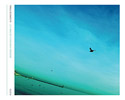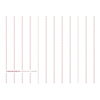 After a few limited digital releases, this 23 year old Polish composer has released two albums near each other temporally, and while both focus on pure, gliding tones, Let’s Make… emphasizes the more digital and static elements of his sound, while Painting Sky Together leans more towards his fondness for simple tones and field recordings.
After a few limited digital releases, this 23 year old Polish composer has released two albums near each other temporally, and while both focus on pure, gliding tones, Let’s Make… emphasizes the more digital and static elements of his sound, while Painting Sky Together leans more towards his fondness for simple tones and field recordings.
Let's Make Better Mistakes Together is structured like a traditional LP, where the first five tracks are the side of the record emphasize shimmering, high frequency passages of treated guitar and piano before transitioning to the darker, murkier second side. "Shimokita" layers swirling bell-like tones over subtle field recordings of conversations, the ethereal layers of bell are paired with similar orchestral flourishes. "Raspberry Girl" floats along similarly, with drawn out harmonium/harpsichord-esque tones with minor changes throughout, the most notable of which is a subtle layer of digital static that doesn’t detract, but adds additional warmth to the already light piece.
Starting with "The Sketch," featuring Adrian Klumpes, the disc beings to take an obvious darker turn. The gentle glassy tones from before are replaced with droning bass pulses, and even with the warmer synth passages the piece has a cold, distant feel. Dissonant piano playing is overshadowed by the glitchy/digital noise elements here, and jarring, harsh field recordings cut in just as the piano takes a turn towards the jazzy. The short “So” is similarly bleak, leaning again on the low end and processed/filtered noise is all around, though the purer tones stay the focus throughout. The closing "Night" is the culmination of this virtual "side" of the album, showcasing digital crackles with bass drones that, for all its darkness feels more mournful than tense or terrifying. The second half of this disc is the more dynamic one in my opinion, with the darker textures being more varied than the sustained, more rudimentary lighter ones on the first half.
samples
 Painting Sky Together, which was released prior, has a greater emphasis on field recordings as an instrument, but also sways more in the lighter and airy direction as the first half of Let’s Make… Opening and closing with "Your Whiteness" and "Movie," both pieces feel related, leading off with repeated electronic fanfares and string-like passages, though the former has a light layer of clicks and static while the latter is more varied and features field recordings of running water. "Freckled Cheeks" is similar with its hovering electronic tones and synthetic pings, alongside a bit of Rhodes piano. The static here is somewhere between digital and organic, and provides a nice counterpoint to the otherwise sterile crystalline sounds.
Painting Sky Together, which was released prior, has a greater emphasis on field recordings as an instrument, but also sways more in the lighter and airy direction as the first half of Let’s Make… Opening and closing with "Your Whiteness" and "Movie," both pieces feel related, leading off with repeated electronic fanfares and string-like passages, though the former has a light layer of clicks and static while the latter is more varied and features field recordings of running water. "Freckled Cheeks" is similar with its hovering electronic tones and synthetic pings, alongside a bit of Rhodes piano. The static here is somewhere between digital and organic, and provides a nice counterpoint to the otherwise sterile crystalline sounds.
While never reaching points as dark as the previous album, "Tokyo" does have more chaotic field recordings and lower register piano notes that are overshadowed by the natural sounds, which ends with gentle reversed tones and sounds of walking through nature at the end. Similarly, the physical movement is also present in "Agata’s Film," which has a dynamic sound over conversations and icy electronic swells. It departs more from the other tracks about midway through, where it becomes a collage of electronic loops and sequences that are far less pure than the other pieces.
Both "So Fragile" and "Mi.Ti" are also somewhat dissonant, with the previously unadulterated tones being cut up and roughly panned between channels, the former layering in warm static while the later has clicks and pops that resembles a rope being slowly tightened to dangerous levels. The long “January” also has layered tones that become more and more raw as it goes on, closing with raw field recording sounds that are harsher than any other elements in the track.
Considering his youth and upstart discography, Bednarczyk is already demonstrating his skills at composition as well as an ear for pure, droning tones. Between the two albums my personal preference is more towards Let’s Make… because I prefer the darker elements of his sound, and those pieces are also more dynamic and varied. Both, however, are great on their own merits.
samples
Read More

